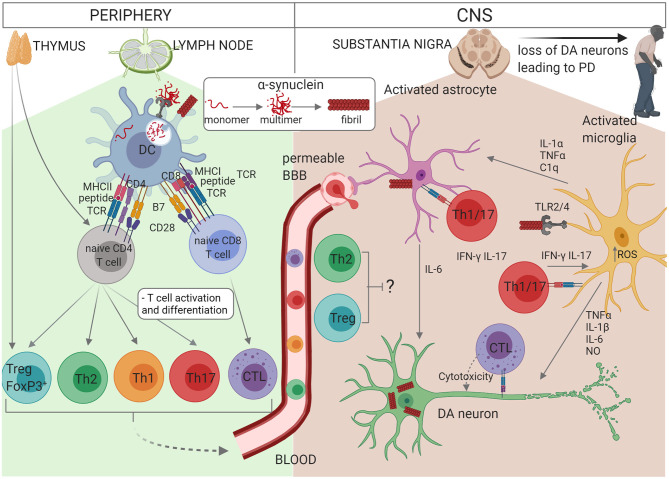Figure 1.
Schematic representation of the interactions between glial cells and immune cells in PD. Self-reactive α-syn-specific naïve T cells may have escaped thymic selection, or alternatively post-translationally modified α-syn may be recognised by naïve T cells as a neoantigen. In individuals with PINK1/PARK2 mutations, mitochondrial antigen presentation may also result in T cell activation. Autoreactive CD4+ or CD8+ T cells circulate through the lymph nodes where they may become activated by a dendritic cell (DC) presenting α-syn antigen via MHCII or MHCI, respectively. α-syn or other DAMPs activate the DC via PRR to express co-stimulatory molecules (B7) and cytokines which drive the proliferation and differentiation of effector T cell subsets. CD4+ T cells differentiate into Th1, Th2, Th17, or Treg cells depending on the cytokine milieu and CD8+ T cell differentiate into cytotoxic lymphocytes (CTL). Effector T cells traffic via the blood and extravasate through a permeable BBB into the CNS, where they re-encounter their α-syn antigens presented via MHCI on neurons or MHCII on astrocytes or microglia. Th1 and Th17 cells produce pro-inflammatory cytokines IFN-γ and IL-17 which contribute to the activation of astrocytes and microglia in synergy with other cytokines such as TNF-α, and CTL induce apoptosis in DA neurons. On the other hand, Treg and Th2 cells may protect against neuroinflammation. The accumulation of modified or aggregated α-syn is thought to be a key initiator of PD. α-syn accumulates within DA neurons and can also be secreted where it activates astrocytes and microglia. Activation of TLR2 or TLR4 by α-syn together with increased intracellular ROS activates the inflammasome. Activated microglia secrete TNF-α, IL-1β, IL-6, and NO which promote DA neuron degeneration. IL-1α, TNF-α, and C1q from activated microglia also activate astrocytes which in turn secrete IL-6, IL-1α, IL-1β, and NO. In addition, activated astrocytes exhibit decreased release of protective neurotrophic factors and impaired glutamate uptake. Thus, T cells, astrocytes and microglia cooperate to perpetuate neuroinflammation and loss of DA neurons in PD.

